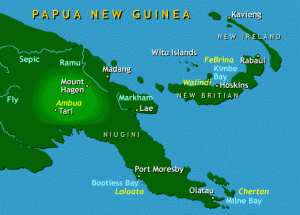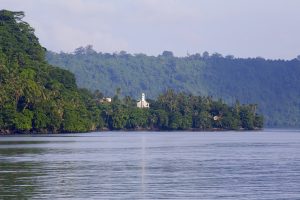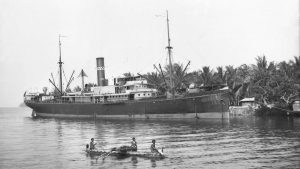- Author
- Editorial Staff
- Subjects
- History - WW1, History - WW2
- Tags
-
- RAN Ships
- None noted.
- Publication
- September 2015 edition of the Naval Historical Review (all rights reserved)
P & O’s Pacific Dawn recently completed a two week cruise to Papua New Guinea (PNG) with calls at Alotau (Milne Bay), Madang and Wewak. Unfortunately a low on-shore swell precluded tenders landing at Wewak, with a problem then arising of what to do with 1,800 passengers transiting the Bismark Sea with a day to spare before making their next port of call at Rabaul. With the entrepreneurial flair of an Italian captain and the local knowledge of an Australian “Reef Pilot” an unexpected call was made to the Witu Islands.
The Witu Islands are a group of three main and five smaller islands situated about 50 nautical miles off the northwest coast of New Britain, the remnants of volcanic peaks jutting above sea levels with extremely fertile soil and abundant rainfall; all are covered with luxuriant vegetation. The largest, known as Garove or Great Witu, has two spectacular harbours formed following massive volcanic eruptions in past centuries resulting in two calderas which are both linked to the sea. This now sleepy backwater with clear blue waters makes an excellent dive centre. A glimpse behind nature’s bounty also reveals past historical riches well worthy of attention.

An early settler, the Danish seaman Peter Hansen, managed plantations here on behalf of “Queen Emma”; becoming well known for his harem of 26 concubines. Emma a Samoan married to a German planter ran extensive and profitable copra plantations throughout the South Pacific with their headquarters at Rabaul. Before synthetic alternatives copra, the dried kernel of the coconut, was the main ingredient of soap, margarine and glycerine. Post WWI the plantations of the Witu Islands were acquired by the Australian trading company with the Emma’s crown passing to the new king of the South Pacific, Burns Philp.

The impressive larger caldera named Johann Albrecht Hafen is about 5 kms wide and 300 meters deep, while this could accommodate a large fleet finding suitable anchorages at such great deeps may prove tenuous. A German Catholic mission was established here and a small railway with carriages pulled by oxen linked the port with inland plantations. The smaller caldera of Peterhafen which faces the north coast is most picturesque and is protected on all sides against the strongest winds. Both harbours are almost invisible from seaward and in the days before air surveillance provided excellent concealment.
WWI and the Wolf strikes
Probably the most famous German raider of WWI was SMS Wolf with her cub the equally impressive floatplane Wolfchen. She is credited with sinking 14 ships, mainly by efficiently laying mine fields which caused naval ships to be diverted to protect troopships and merchant routes which had previously been thought free from enemy action. She is historically important being the first enemy vessel to cause loss of lives and ships in Australian and New Zealand waters. Wolf, with top masts lowered keeping her safe from prying eyes, created a lair here for a short period. At least this is the story conveyed by our Pilot and supported by some written evidence with local folklore saying she came here to replenish and clean her hull. As her known passage would have taken her close to the islands it is not unreasonable to speculate that she would investigate this hidden harbour, well known to the German Navy. Another frequent visitor was the German governor’s yacht Komet (later HMAS Una) which was at Witu in August 1914 and later at nearby Komethafen near Talasea where she was captured by Australian forces.
It was in these waters on 6 August 1917 that Wolf, desperately in need of bunkers, was combing the sea lanes for a likely victim. After giving her position away by radio the Burns Philp steamer Matunga was intercepted by Wolf. This wondrous prize came loaded with supplies and civil and military personnel destined to support the Australian Naval & Military Expeditionary Force; most importantly 500 tons of best Westport steaming coal intended to resupply Una, plus another stock pile of 1,000 tons of coal for the inter-island trade and her own bunker supply. Embarrassingly Matunga passengers included two senior army medical officers returning from furlough, Colonel Strangman and Major Flood with Mrs Flood. She also carried Rabaul’s next stock of beer, wines and spirits which was welcomed by the Germans and sorely missed by the garrison.
Wolf escorted her prize to another island of Waigeo (Waigeu) across the border with neutral and friendlier Dutch New Guinea. Here for nearly two weeks the quiet haven of Offak Bay became home for transfer of bunkers, stores and personnel. The opportunity was taken to clean the great growth of weeds which infested Wolf’s hull and had reduced her speed by more than two knots. This exercise was carried out with the assistance of diving parties. When all conceivable stores and materials had been taken from Matunga she was towed offshore and scuttled.

WWII and Japanese occupation
During WWII the importance of the Witu islands was recognised by the Japanese who based small craft here and installed an anti-aircraft battery. Don Carroll, who in the 1960s was a plantation manager for Burns Philp at Witu and a passenger on Pacific Dawn, recalls the remains of wrecks of Japanese ships which had been subject to American bombing raids showing above the harbour, these have now disappeared below the surface. However the AA battery of 75mm type 88 guns remains in evidence.
Following the Japanese invasion of Rabaul a number of Australians, both troops and civilians, fled further south into New Britain. Keith McCarthy, a District Officer at Talasea, was a tower of strength in these extreme situations and placed in charge of evacuations. By now McCarthy had gained a flotilla of small craft but these were unsuitable to make a break-out over open seas. McCarthy learnt that the Burns Philp 340 ton motor trading vessel Lakatoi lay hidden at Great Witu. With a small launch an overnight passage was made to Witu and at gunpoint the master of Lakatoi was invited to hand over his well provisioned vessel. The remainder of the small vessels then made an overnight passage to Witu. Lakatoi was loaded with flammable copra which was jettisoned to make way for the new arrivals. Flying an improvised white ensign she was unofficially commissioned into the RAN and began the hazardous voyage through enemy controlled waters by a series of overnight transits and anchoring close inshore covered with vegetation during daylight. Two Coastwatchers volunteered to remain at Witu. Lakatoi reach the safety of Cairns on 28 March 1942 with 214 escapees; only six of these were medically fit on arrival.
Before occupying the Witu Islands they were over flown by Japanese who bombed and strafed suspected Australian positions. It was time for the Coastwatchers to leave and at night on 18 January 1943 a Catalina flying boat made a successful landing at Johann Albrecht Hafen, taking off the remainder of the Australians.
It is known that Burns Philp’s diminutive but classically proportioned passenger liner Bulolo (requisitioned by the Royal Navy from 1939 to 1946) occasionally called at Witu but at only 6,500 tons she was comparatively small. Possibly she is the largest ship to have called at these islands but in February 2015 this record must surely now have been broken by the 70,000 ton Pacific Dawn.
Nothing in the numerous books on the German raiders or the RAN Official War Histories supports Wolf calling at Witu, so this is just folklore although it remains a good story.




